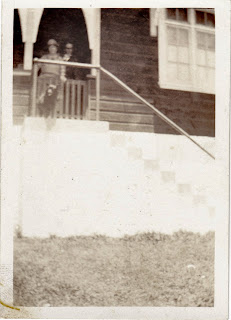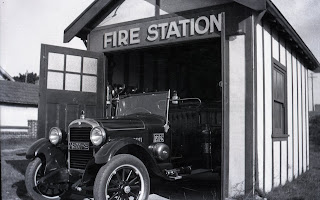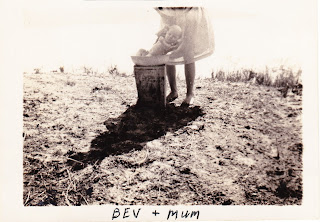Arthur Thomas Herbert Roberts, as he always called himself, on official occasions or Arthur, on formal occasions and Artie to friends, was born on the 21st of January 1898, at his parent’s home in Riley Street, Surry Hills; an inner city suburb of Sydney, which at that time was well known as a slum area. A good description of the area and times can be found in the novel “Foveaux” by Kylie Tennant.
He was the 2nd eldest of eight children born to Thomas Roberts and Elizabeth Olive Dillon.The grandparents of both his parents were convicts, sent from Britain to New South Wales between 1830 and 1850. John Roberts and Sophia Chapman were his paternal Great grandparents, while his maternal Great Grandparents were Olive King and James Lefroy. Arthur's eldest sibling, Olive was born in Surry Hills in 1896, while his youngest, Mavis France, was born in 1916 at their new home "Olveena" in Austral Street, Long Bay, where she lived for the whole 91 years of life.
As a child he used to walk the 8 miles out to Long Bay with his father Thomas, to visit his aunt, Hannah Roberts, his father’s sister. Hannah had married Lawrence “Larry” Burns in 1896, and had moved to Long Bay around 1900. In 1910 Arthur’s family also decided to move from the inner city to the almost unknown suburb of Long Bay,with its fresh air, clean drinking water, seaside and space. Long Bay had been “settled” less than 25 years earlier. But for many thousands of years had been home to the local Aboriginal people, many who still resided there, while the newcomers built around them.
 |
| A.T.H. Roberts, 1915 |
By this time, at the age of 12, Arthur had finished his schooling, eventually training as a tinsmith, making travelling trunks.
At the age of 17 and 10 months, on the 8th of November 1915, he joined the Australian Imperial Force and was enlisted into the 19th battalion (The South Sydney Battalion)
Records show that he lied about his age, which is listed as being 18 years and 9 months. The Army records also show that he was 5’ 2” and weighed 8 stone, 3 pounds, when he left Australia on the 12 December from Sydney, New South Wales, on board HMAT Berrima.
 |
| HMAT Berrima |
After stopping over in Alexandria were he was transferred to the 2nd Battalion A.I.F. (the battalion he remained attached to for the rest of the war), he arrived in Marseilles, France in March of 1916, and by late July 1916, was wounded in the battle of Pozieres, when up on a church wall, a shell exploded and a piece of shrapnel was lodged in his temple. Arthur was one of only a handful of men to survive such an injury, but he always claimed that he survived because he was ordered to walk from the front line to find medical assistance, as the battalion was in retreat. In his words, “the circulation from walking helped me survive”. He was eventually sent to the Third West General Hospital near Cardiff, Wales in August of 1916 for recovery, but by October of 1917, he was back in France. Put on cooking duties, he spilt a large pot of boiling water on his right arm, and was again sent for medical treatment.
He returned to Australia on His Majesty’s Troop Ship, “City of Poona”; leaving Southampton in England on the 28th March 1919, and arriving in Melbourne in Victoria on the 14th May 1919, from where he had to make his way home to Sydney by train; a distance of some 600 miles.
On his return home, he was presented with a special 9 carat gold medal inscribed “Pres TO, A.T.H. Roberts, from his friends A. & AE SUMNER, on his return from the, GREAT WAR, 17. 5.19” ; Mr Sumner being the well known and respected local Anglican Minister at St. Mark's Church of England.
Once home, even the peaceful, sleepy suburb of Long Bay could not settle his nerves. He left Sydney and “went bush” down the south coast of New South Wales near Shoalhaven, staying away for four years. On his return home around 1923, he bought a horse and cart and went around the local area selling fruit and vegetables, many of which he bought from the local Chinese market gardeners at Matraville. When a green grocer’s shop opened in Long Bay, it was Arthur who supplied them with their produce.
In 1924 he bought a Ford truck to carry on his old business more effectively. In the year before he passed away, John Anderson, a pioneer of Long Bay who had had a long running carting business, sold his business to Arthur, whom he thought was a dependable character, thus his truck was named "Dependable". The goods Arthur now carted included coal, coke and wood which households burnt for heating and cooking, and ice to keep food cold, as electricity was connected to only a very few of the houses in the area, and refrigerators were not yet on the market; it took his wife Doris until the 1970's to give up her “Ice Chest” for such a new, and in her opinion, useless Electric Refrigerator!
 |
Newly weds, Arthur and Doris,
leaving All Souls Church |
1924 was an eventful year for Arthur, as he also met his future wife, Doris Louisa Morgan, at one of the many dances that were regularly held at Anderson's Hall in Victoria St. In June 1926, they were married at All Souls Church of England in Petersham, back near where they had both been born.
 |
| Arthur and Doris in their new home |
The newlyweds settled in a cottage named “Longhaven” in Prince Edward St. Their first daughter, Doreen Lorraine was born in 1927. Business remained promising, and Arthur bought a number of housing blocks to ensure his family’s future.
When in 1929, the world was hit by an economic depression, Arthur continued to give service to clients even if they could not pay. The couple began to argue, as Doris believed that many families whom had pleaded poor, could in reality, afford to pay as many husbands worked on 'the quite' or QT as it is said in Australian slang, while her family went without. Arthur however, kept up his charitable attitudes by giving a lift to men he saw walking to Moore Park for food handouts, even though he could barely afford the petrol. He continued to struggle economically, and the blocks of land he had purchased against such an eventuality had to be sold. He would never consider signing up for “The Dole” nor accept handouts himself, but continued to struggle financially, while maintaining his compassionate work. However, soon all his assets were gone and he was left with nothing.
 |
| Long Bay Fire Station, Raglan St., Malabar |
In 1929 Arthur became a notable member of the local Volunteer Fire Brigade, located in Raglan St, near to where he lived with his new family. Arthur was an active member until 1965, just over 35 years, being given life long membership and a medal for long and outstanding service.
Arthur was also a founding member of the “Long Bay Social Club”, set up to assist, and provide sustenance and entertainment for those unfortunates who had settled at Long Bay after losing their livelihoods, homes and sometimes families during the "Great Depression"
By this time, Arthur and Doris had another daughter to feed; Beverley Frances born in late 1928. Doris had also had stillborn child during this period, and the family must have been in turmoil. His health began to suffer, and on doctor’s orders, he moved with his family to Shoalhaven Heads; his old stomping grounds of the South coast of NSW. The family lived in the back of his truck until he found somewhere to rent.
 |
| Baby Beverley being Bathed |
After six months respite, he returned to Malabar living in Raglan Street, while building a new house for his family, next to his mother's home in Austral Street, on land previously purchased by his father Thomas who had recently died. Many friends aided him in his building work; the blueprints were donated to, and are now held by, the Randwick and District Historical Society.
One boon for this period was the wreck of the ship "The Malabar" in 1931. Despite the official efforts in trying to stop the public taking home the cargo that had washed ashore, or floated in the bay, the temptation was too much for many Long Bay residents; with barrels of butter, nails, wood and many more useful and even life-saving items being there for the taking. Items were hidden when Custom's Officers came to investigate the missing cargo. The SS Malabar contributed to the suburb in one more very important way, and that was its name; In 1933, Long Bay was officially renamed "Malabar"
Life went on relatively smoothly for Arthur and Doris, though busy working, dancing and raising three daughters; Marjorie had been born in 1933. The beginning of World War II began to impose hardship on the population once more. Being good at his business served him well, and he soon gained employment with the Royal Australian Naval Dockyards as a carrier of goods. Many of the invoices from this period show that he was indeed a very busy man. He continued his work with the dockyards until 1954; well after the war had ended.
Dances were an integral part of their lives as well as other social activities like organising cricket matches between the warders of Long Bay and Emu Plains Prisons. All the players would load themselves on the back of "Dependable" and Arthur would drive the many miles out past Penrith for the game
Arthur, along with his father and other family members was a member of the Long Bay Masonic Lodge which is still operating strongly today
 |
21-4-31
Lodge Long Bay 569 ANZAC Night |
Arthur passed away in 1985, aged 87, with 8 grandchildren, and 14 great grandchildren, loved by all, he was not just a family man, but an integral part of the whole community
 |
Arthur and Doris with Great Grandson,
Patrick, 1981 |
|
Sources:
National Archives of Australia, WWI personnel record
Family papers, diaries and photographs
NSW Registry for Births, Deaths and Marriages
Archives of NSW photos on Flicka and the National Library of Australia
Notes taken by his daughter, Marjorie Roberts from talking to her father
Australian Electoral Rolls
Randwick : a social history



















